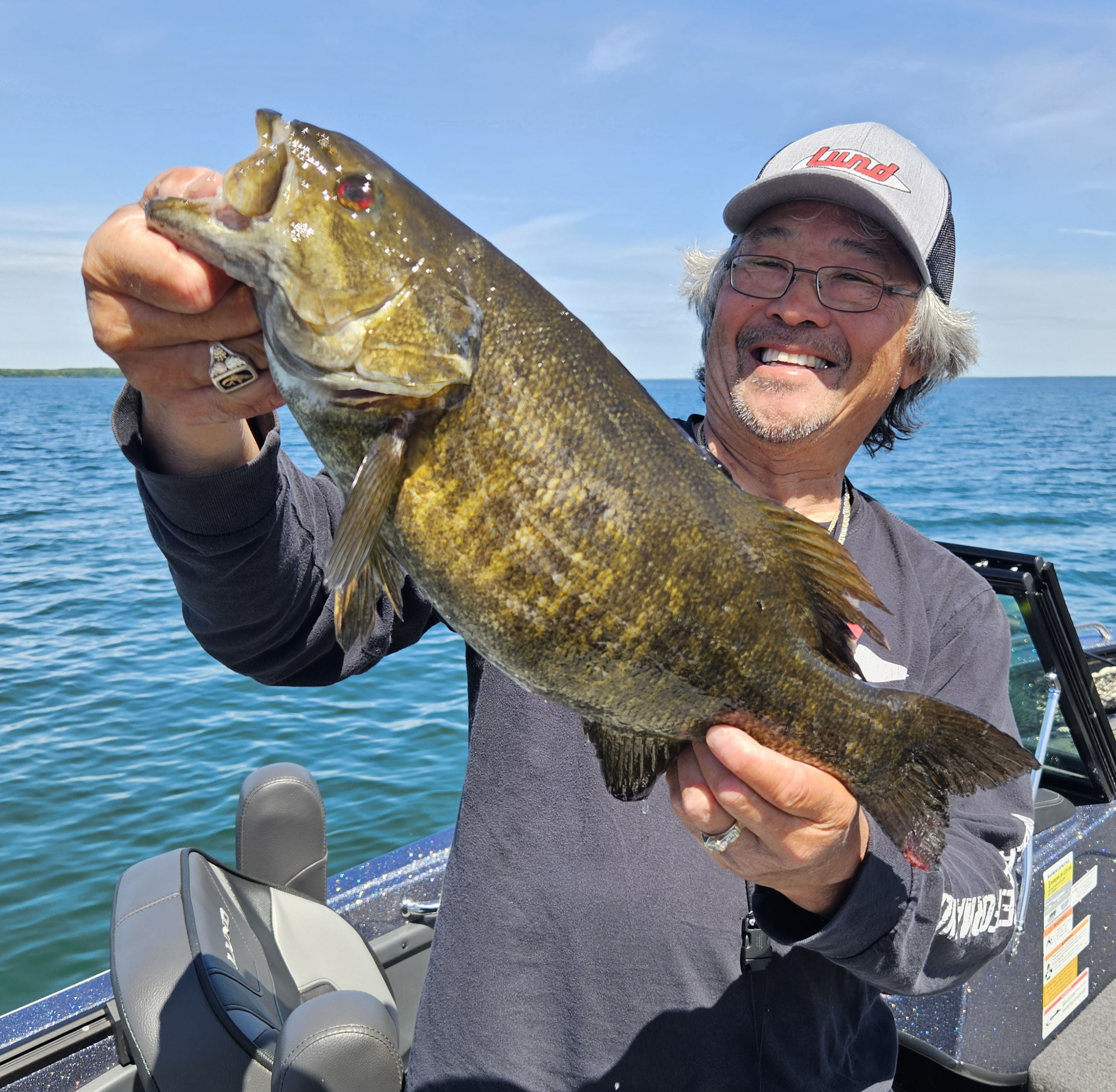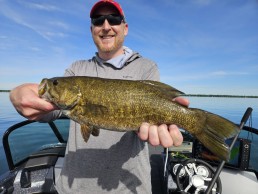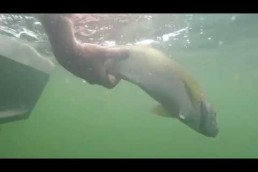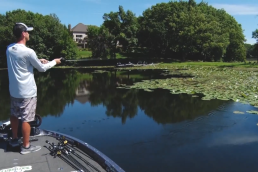Jumpin’ Jack Smallmouth Bass
SHARE THIS POST
Dynamic fighters and Jumpin’ Jacks: smallmouth bass are memory makers. For instance, I recently took the new President of Lund Boat Company, Jeromie Johnston, out to fish for some walleyes on Mille Lacs Lake this past month. We had really meant to catch a few walleyes, but the smallmouth bass quickly changed our minds. It was epic!
We started out by slow trolling 1/2-ounce live bait rigs, and 1/4-ounce jigs tipped with shiners, along the deep edge of the rock reefs on Mille Lacs Lake during the late May timeframe. We were a bit stymied by the lack of bites as we trolled and drifted in 18 feet of water, just along the deeper edge of the rocks. We would occasionally cast a jig/Rattle Paddle swimbait combo over the tops of the reefs as the wind started to blow. We didn’t have much luck in the first few minutes until Jeromie saw his line go slack and a bronze bomber busted the surface and went airborne! Jeromie might as well have lit the fuse on an M80 firecracker as this bass went crazy! After a heart pounding battle lasting what seemed like a lifetime, a 19-incher (Jeromie’s personal best) was finally subdued and netted!
We proceeded to catch several more over the next 2 hours as our wrists and arms earned a “feel good” soreness! All the fish we hooked up were 2 to 4 pounds! The beautiful bass fought like fish twice their weight. Other species of fish may get bigger, but they certainly don’t fight harder, pound for pound, than smallmouth bass. When first hooked, smallies are like copper-colored rockets that shoot out water of cruise missiles launched from a submarine. It a blast catching them on medium-light JT Outdoors Mag Medium Light rods teamed with spinning reels spooled with 10-pound-test braid.
Once we find them, catching smallmouth bass usually isn’t rocket science. You just need to know what makes smallies tick and be willing to keep moving until you connect. When it comes to smallmouths, it’s often a case of find one, you’ll find many more.
All fish want three things: the right water temperature, security and food. For smallmouth bass, the best spots are usually close to deeper water for escape, in addition to “cover” consisting of boulders or weeds. Vegetation also gives smallies a place to hide and a vantage point from which to ambush prey.
Smallies in Minnesota love to feed on crawdads which inhabit the rocks, and young-of-the-year baitfish of all kinds. Bug hatches provide a main course at times of the season.
Smallmouth action ramps up when the water temperature reaches 50 to 55 degrees in spring as they gather to spawn on sandy, gravelly, hard-bottomed, shoreline-related structure. Most northern states’ season openers are timed to protect the adult fish while they reproduce. Fish are done laying their eggs after the water temperature is 60 or above. But the adult fish don’t roam far if what they need to eat is close by.
Smallie metabolism increases with water temperature. As the summer progresses, the fish become more aggressive. Mid- to late-summer bites can be awesome! Fast-moving lures such as spinnerbaits and jerkbaits often work well.
As we saw on our trip to Mille Lacs, huge schools of bass will move away from the shoreline as the season progresses and water temperatures rise in the shallows. They’ll often be found on offshore humps and islands, much like walleyes. In fact, you’ll often find smallmouth bass in the same areas as walleyes from June through the remainder of the summer. Of the two, bass typically remain a bit shallower. Being low-light predators, walleyes will hunt the tops of the humps or along shallower wind-beaten shorelines just like smallmouth bass, especially if a breeze rustles the surface enough to cut the glare of sunlight.
Are you enjoying this post?
You can be among the first to get the latest info on where to go, what to use and how to use it!

The tactics to catch them vary depending on the depth of the water and the mood of the fish.
Shallow water often means sight-fishing or the use of Humminbird’s Mega Live forward-facing sonar. Stay mobile to locate fish on larger rock structures. Reefs can be huge. Don’t waste your time. Keep moving until the first smallmouth tips you off to the location of the school.
Topwater baits work when they’re shallow and aggressive. Try something with a propeller or a rattle that makes noise when jerked through the water. When starting out, make sure everyone uses something a little different to start with, whether it be profile, size or color. Let the fish tell you what they want that day. I promise you that it won’t take long.
Slow down when fishing in deeper water or when bass seem less aggressive. Slow-swim a 1/4-ounce jig tipped with a 3- or 4-inch Lake Effect’s Rattle Paddle Fire Newt swimbait (lakeeffectlures.com), which mimics a rusty crawfish, over rocks in 4 to 5 feet of water. Drop the jig back at them if you are getting short strikes. Stick baits and jerk-shad-style baits work as well.
As we proved, a simple live bait rig combined with a shiner or leech is also a great way to check out deeper structure.
Exceptions to the rock scenario occur in spring and later in fall when targeting weeds can be productive. Though weeds hold more walleyes and largemouth bass, smallmouths will hunt the same spots. Try spinnerbaits then as well.
Jim DeRosa, another outdoor personality friend of mine, guides on Mille Lacs Lake for smallmouth bass. He believes that the deeper mud flats are an untapped smallmouth bass location. He uses his Humminbird side-imaging sonar to search the soft-bottomed flats for the odd boulder or isolated rock pile, which can harbor bass. His record is nine fish caught from a single boulder no bigger than the hood of a car. Find a spot like that, mark it on your GPS and the smallmouths will be there day after day.
Try taking a smallmouth bass trip this summer. You can expect some bronze-colored fireworks if you do!
MWO
SHARE THIS POST
Did you enjoy this post?
You can be among the first to get the latest info on where to go, what to use and how to use it!
Ted Takasaki
Ted Takasaki is an International Fishing Hall of Fame professional angler who has been featured in many national outdoor magazines and television shows. Takasaki has appeared in front of thousands of angling enthusiasts and is considered one of America’s top walleye and multispecies anglers. Follow him on his Facebook page.



